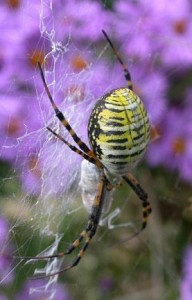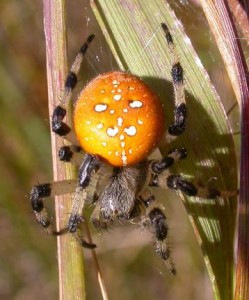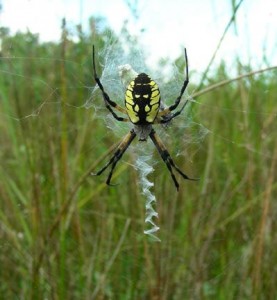Arachnids of Halloween: Learning not to fear
- Share
- Tweet
- Pin
- Share
Are you an arachnophobe – a person afflicted with an abnormal fear of spiders? Many are, and I may have become one myself had it not been for a valuable experience I had in the fall of 1951 as a fifth grade practice teacher in the lab school under Miss Cozette Groves at UW-Oshkosh.
It so happened that Miss Cozette hated snakes and spiders, which in turn prompted a few of the boys, known for having a slight mischievous streak, to wait until Miss Groves left the room so they could perform one of their little pranks.
They’d rush to get one of the World Book Encyclopedias featuring either spiders or snakes, open to one of the colored pages, and hide the book on the teacher’s desk chair. She’d return to the room, nonchalantly slide the chair out, see the “fearsome” pictures, throw up her arms and let out with a loud gasp. The students knew what to expect, giggled their heads off, and the teacher never made a huge issue out of the prank. I often wondered thereafter how many of the students disliked snakes and spiders based upon their teacher’s fear of them. Then and there I vowed to never show a fear of snakes, spiders or other “creepy crawly” things in front of my students and to learn as much as I could about them and especially to respect them.
One of my all-time favorite people, Donald Culross Peattie, the famous naturalist-writer of past years, said while observing an adult helping a child to watch a spider spinning a web, “If he (a child) learns admiration instead of disgust for the tiny spinner, he will have learned one of the greatest lessons in nature – that all life is sacred.”
I have the utmost respect for Larry Weber, who has written two incredibly wonderful field guides, “Spiders of the North Woods” and “Butterflies of the North Woods,” available at some county book stores and nature centers. My wish and recommendation is that every elementary classroom, library and home should have them. As a dedicated spider watcher, researcher and photographer, Webber is convinced that this exciting hobby has been known to change people from being spider killers to being spider watchers and admirers.
Rest easy knowing that most spiders are creatures of the night and hide during the day, are very timid and not aggressive in the least, and never go “hunting” for humans to bite. Very few in our region, containing several hundred species, have jaws strong enough to even puncture a human’s skin. Dr. Mike Draney, biologist and spider expert at the UW-Green Bay, also claims that nearly all so-called spider bites turn out to be insect bites.
Dr. Draney’s research indicated that there have been very few proven sightings of the Brown Recluse spiders in nearly all counties in Wisconsin, and that they will bite only when disturbed. Very few Northern Widow Spiders have been documented as well. I have seen several Northern Widow Spiders, close relatives of the Black Widow Spider, that were captured a few miles east of the Gibraltar School. They had been hiding and hunting near the base of stone walls and were harmlessly discovered by a young child. Yes, this spider is considered to be very poisonous.
We have our share of Long-bodied Spiders doing their hunting in our basement. Anytime we find a spider in the house we take an empty cottage cheese container and a thin sheet of paper, harmlessly trap the spider beneath the container, slide the paper under the spider thereby capturing it, and simply release it outdoors. Emma Toft taught me this many years ago in that she was a great respecter of life.
Several of my favorite spiders include the Daddy Longlegs, Long-jawed Orbweavers which often inhabit our front-yard Zinnia patch, Crab Spiders, also called Flower Spiders, which lie in ambush on top of, for example, Queen Anne’s Lace blossoms, and the Yellow Garden Argiope (ar-JY-o-pea), possibly the largest (and most beautiful) orb-weaving spider in our region.
Two years ago this past September my friend Nick Anderson and I lucked onto discovering a beautiful and by far the rarest spider either of us had ever seen, the Labrador Orbweaver. We had been working on a very windy day eradicating the terrible Phragmites plants along the western edge of Moonlight Bay at Toft Point. Prof. Mike Draney had previously discovered one there too and learned by careful genital examination of the specimen that it had never before been found in Wisconsin. It looks very much like the Shamrock Orbweaver found quite commonly in the state.
The other unusual spider I lucked onto at the point in August of 2009, clinging to the outer shingled siding of Fern Cabin, was an approximately three-inch-wide giant of a spider, the Dark Fishing Spider, largest in the state. It is quite commonly found as far as 100 yards from the nearest water. The only larger spider in all of North America is the Carolina Wolf Spider.
In spite of some far-fetched spider and web concoctions devised for scaring passersby, or especially the little trick-or-treaters this Halloween night, take a very positive approach to spiders as suggested in Larry Webber’s great spider nature guide.
We tend to FEAR that which we do not KNOW.
We tend to DISLIKE that which we FEAR.
We tend to HURT that which we DISLIKE,
but in the end
We tend to ENJOY that which we get to KNOW.
Work hard to become partners in nature with the spiders!



